
 |
|
|
#1 |
|
All the news that's fit to excerpt
Name: newsie
Location: who knows?
Join Date: Jun 2008 Motorcycle(s): only digital replicas Posts: Too much.
|
[cycleworld.com] - Josh Herrin and Warhorse HSBK Ducati Win 2024 Daytona 200
What does it take to win the Daytona 200? Much more than outright speed. Josh Herrin gets his third with a prepared team.
Click here to view on their site. 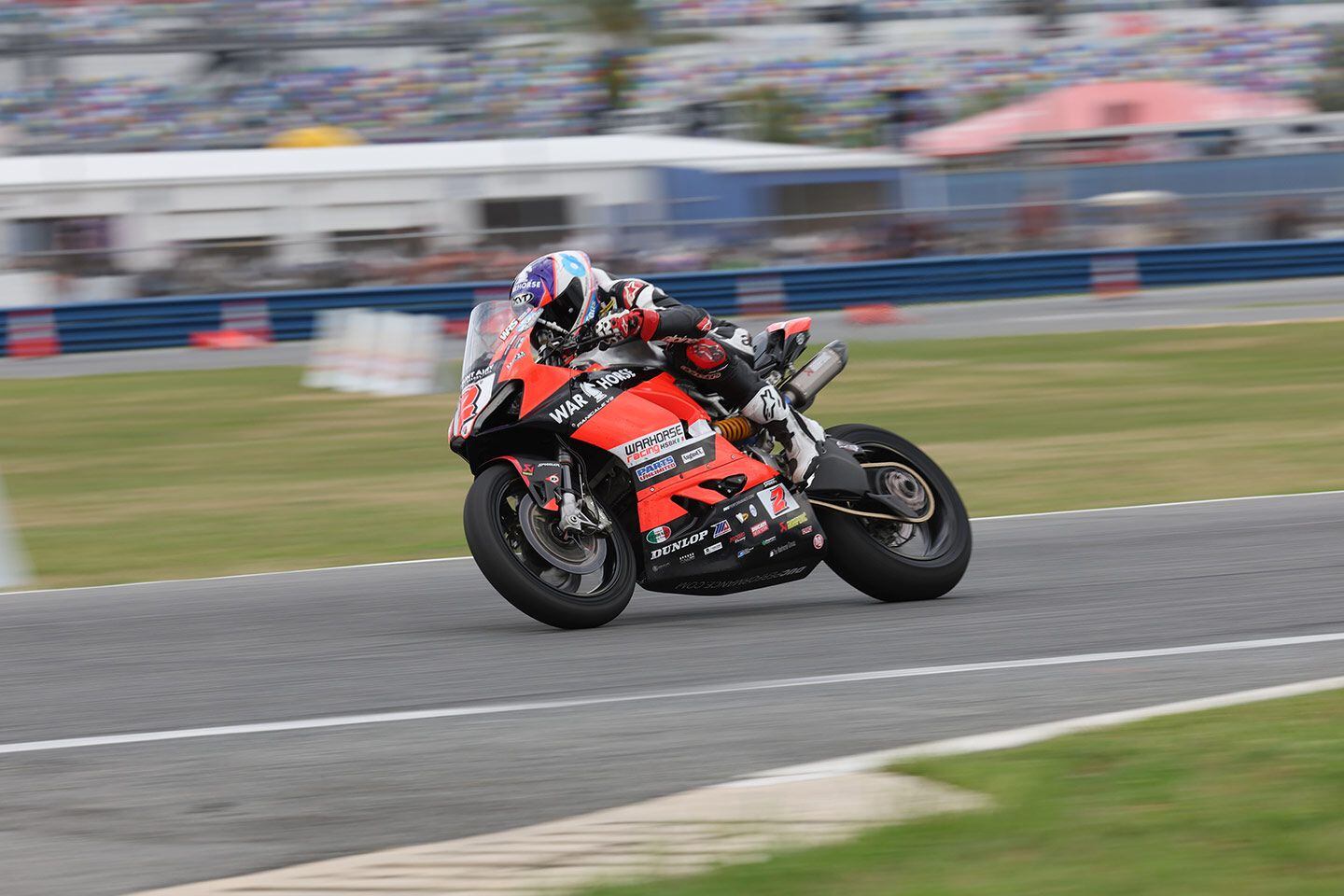 Josh Herrin won his third Daytona 200. (Ducati/)Like Mount Everest, Daytona gets our attention “because it’s there.” A lot has changed since the early days, but the Daytona 200-mile motorcycle roadrace carries on. Last Saturday’s win by Josh Herrin on a Warhorse Panigale 955 Ducati was not really a surprise, but his achievement of a third 200 win establishes him as one of the distinguished multitime winners who know how to stay durably fast on this track through a long afternoon. He also showed the truth of what Kurtis Roberts told us in the entryway of the old Benny Kahn press room years ago: All those miles aren’t racing so much as they are a time for surviving and planning. The final two laps may turn out to be the real race, when the rider who best understands the dynamics of drafting will cross the line first. This time, Herrin won without last-lap drama. 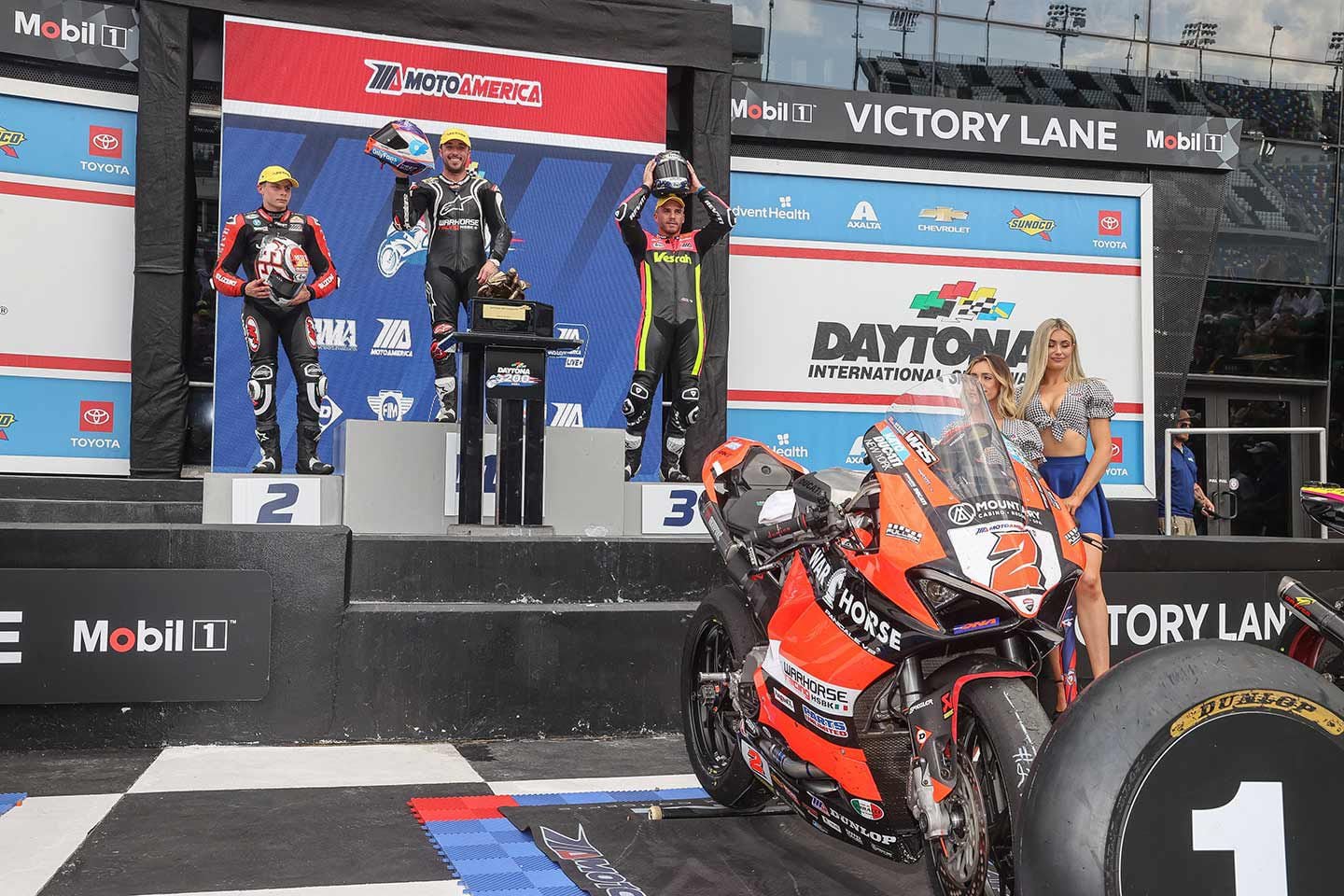 Herrin (center) won his third Daytona 200 without last-lap drama. Tyler Scott (left) was second and Hayden Gillim (right) took third. (Ducati/)Years ago I spoke with five-time 200 winner Scott Russell, asking him what is central to survival and success in the 200. His words were roughly: “When you come off a corner, you want to open up, accelerate hard, spin the tire. At Daytona you can’t. You have to control yourself and think of the tire.” Another essential Daytona skill is getting past the clumps of lappers—not being held up, not using any of your nine lives. I well remember the barely contained fury of Miguel DuHamel, who, having nearly been killed by an erratic slowpoke, was surrounded by Honda handlers trying to keep him from saying things they might regret. He explained clearly: “The slow rider has the extra grip to make sudden moves. The fast rider is using all his grip to go fast, so he’s committed to his line.” The race is long and the track is “not especially smooth.” You see the bikes’ suspension working all the time, and riders are constantly jolted. It’s physical. Pit Stops Every team hopes to execute two routine, professional gas and tire stops. MotoAmerica pit reporter Hannah Lopa had it right when she said a successful stop calls for “…not so much physical speed but precision. The crew must be smooth and deliberate.” In the improvised pre-race “pit-stop contest” with $7,500 to win, I saw what happens so often on race day: fumbles from trying too hard. In one case, the rear axle wasn’t tight and in the other, the team began to push before the air wrench was off the axle. Both were DQ’d. In the race, Herrin’s team did the work professionally. Fuel Management Fuel management means someone on each team must be a competent soloist on the hand-held calculator. What mileage are we getting through practice? Tank capacity limit is 19 liters, or 5 US gallons. When Richie Escalante (M4 Suzuki GSX-R750), running second, ran out of gas during his final lap he did what we’ve all done when a bike has cut out: tried leaning and sloshing, hoping to push remote pockets of fuel to the pump inlet. Rider after rider passed him—a bad dream as a sure second became fifth (he was later advanced to fourth). Previously, he had led third place by a comfy 40 seconds. Word had it they refueled 21 laps from the end. Did they know their tank volume accurately? Were they sure of 100 percent fill-ups? Escalante later commented, “I don’t think this place likes me.” 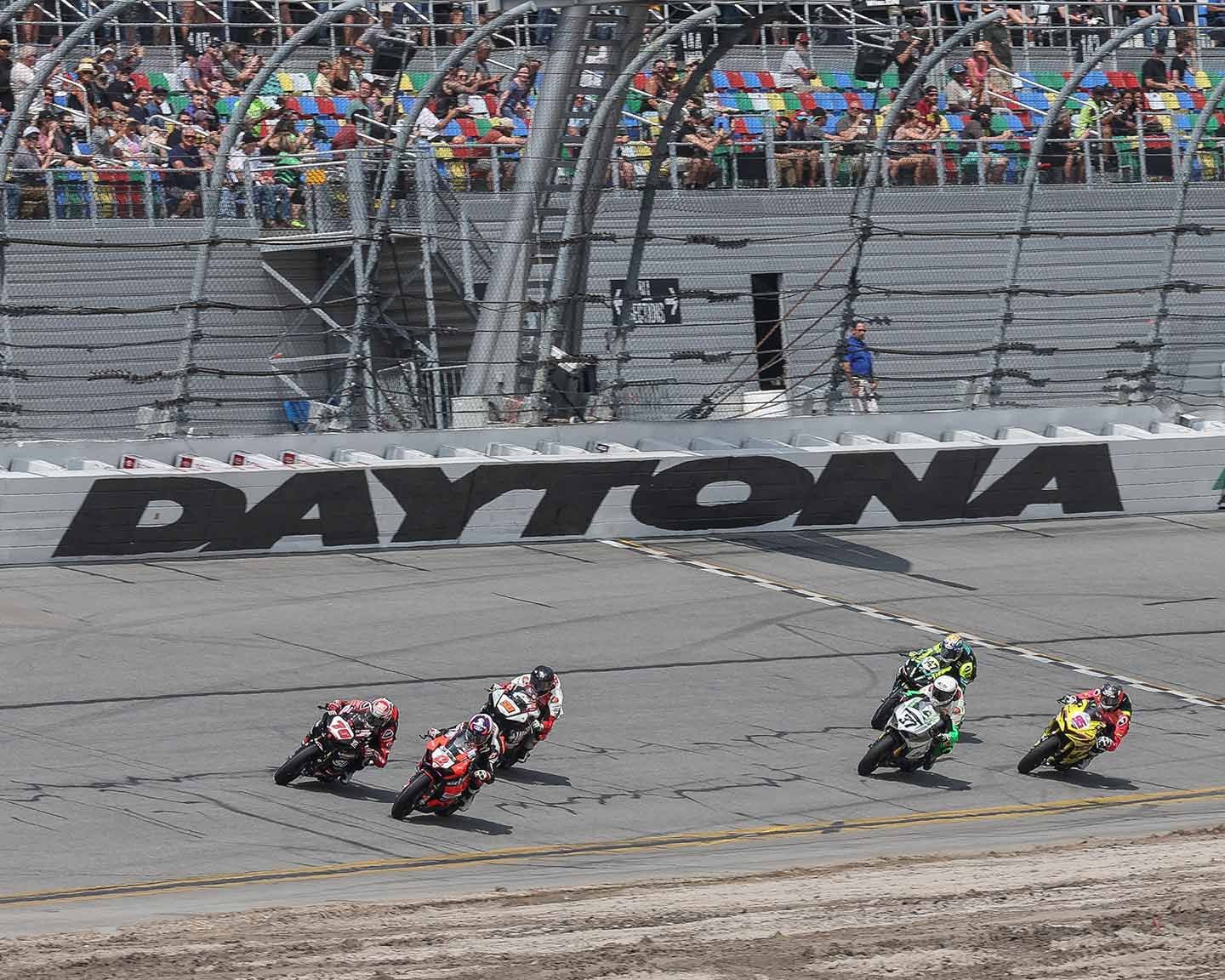 Fuel calculations are key to success at Daytona. (Ducati/)I have seen people take the empty tank to a gas station and “measure it” by filling it from a gas pump. It’s a clever improvisation, but is it good enough? Bobby Fong, one of the early leaders, was disqualified for a slightly oversized fuel tank. Dick Mann on one occasion suggested that a high-finishing rider who knows his tank may be “a little big” would be excused for expressing his joy by punching the fuel tank (only works on metal tanks, of course). Having a 4-liter graduated cylinder enables keeping track of consumption through practice, and it also provides actual knowledge of tank volume. Herrin’s engine cut just after entering pit lane on one of his stops, but he was able to reach his crew. Brandon Paasch (M4 Team Hammer Suzuki) led, then his engine stuttered, and he just made it to his first stop. All went well until the fuel can was lifted, at which point the dry-break valve on the can failed to fully close, the resulting spray making it look like a huge fuel-injection nozzle.* He rode away wet. We were told by the dry-break manufacturer to use new O-rings, lubricated, because there could be cases in which the spring is unable to close and seal the valve. 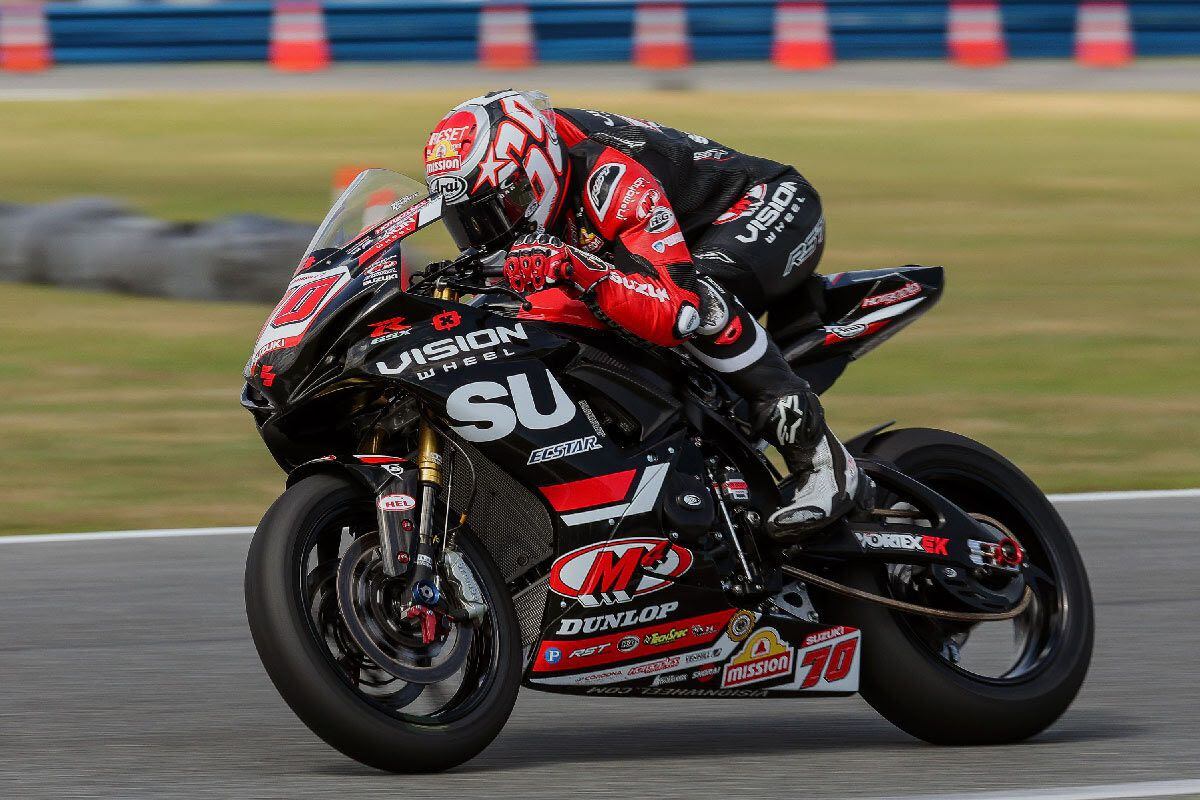 Tyler Scott finished second at the 2024 Daytona 200. (Suzuki/)The difference between the strong, prepared teams at the top and the rest of the field is magnified at Daytona: in 1978, the year of the notorious intake restrictors, Kenny Roberts lapped the field. Near the end of this year’s race, Josh Herrin was lapping ninth place. Changes Over the Years How has Daytona changed? For years, displacement formulas were in force. Back when it was Triumph versus Harley-Davidson, it was 500cc for overhead valve engines and 750 for side-valves. The 1968 Competition Congress reset to a straight 750 formula beginning in 1970, and racing became international, with Triumph, BSA, Honda, and Harley-Davidson factory teams. Daytona became the one race every manufacturer yearned to win. Through the two-stroke years (1972–1984) displacement still ruled: Lightweights were 250s, pro bikes were 750s. Daytona’s driving force in those factory-team days was the hope of pushing product into the world’s greatest market. And how they tried! Honda won it in 1970, BSA the year after, but in both cases it was the race savvy of Dick Mann making it possible. As the two-stroke era began in 1972, the number of Japanese engineers in each team became the yardstick of power. One top crew chief at the time joked that somewhere in the back of the Yamaha garage were two unopened crates. One was stenciled, “Open this one if it won’t run under 2:02,” and the other, “Open this crate if it won’t speed-trap over 190.” Production-based four-stroke 750 Superbikes became the Daytona 200 class in 1985, and the coming of supersport continued the idea of displacement-limited racing: 600 and 750. When the class became 750 two-stroke, 1,025cc four-stroke in 1980, Honda for 1982 entered its tire-eating V-4 “FWS,” and riders Mike Baldwin and Freddie Spencer led effortlessly. Honda came prepared, with trick hardware to enable rapid tire changing. It proved no match for what Daytona can do to rubber. Tire changes have been the norm in the 200 ever since. When it was decided for 2009 that nothing should run over 180 mph at Daytona, 600 Supersport replaced Superbike in the 200. That was when Mat Mladin referred to the 600s as “minibikes.” 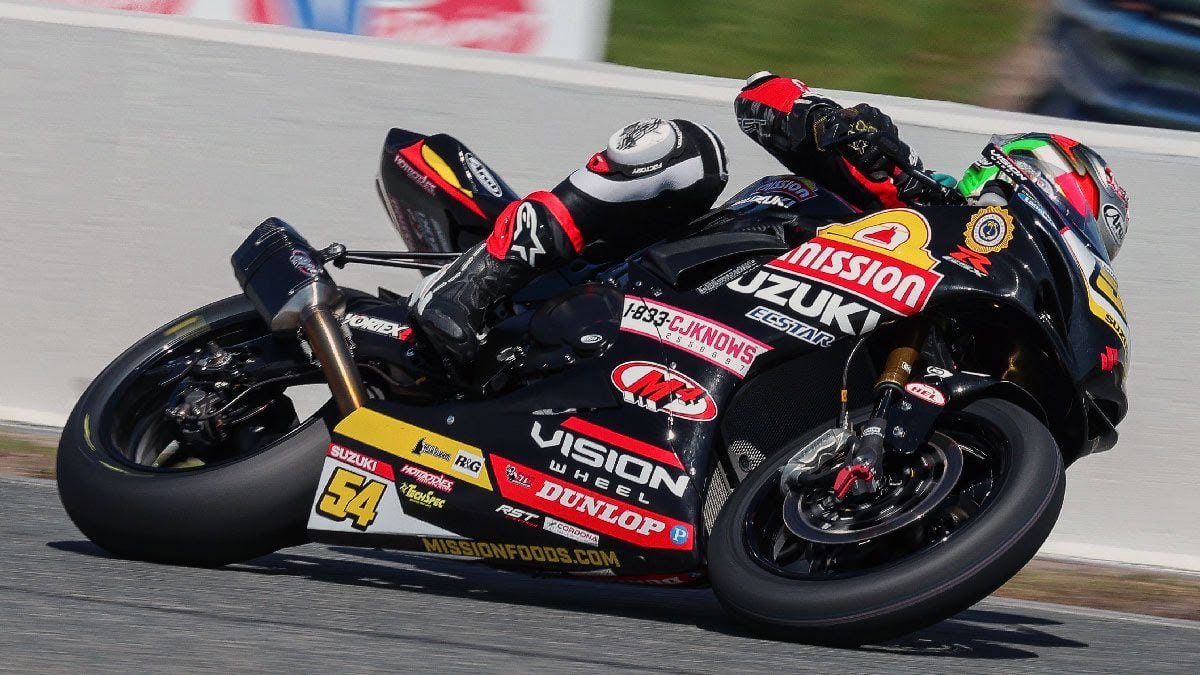 Richie Escalante ran out of gas on the last lap while running second. He crossed the line fifth, but was awarded fourth after Bobby Fong was DQ’d for an over-capacity fuel tank. (Suzuki/)When sportbike sales augured in after the 2008 economic crash, 600 sales collapsed. Whatever shall we do if Japan stops building 600s? A fresh idea emerged: Let’s race bikes of similar lap time, not of identical displacement. This is Supersport Next Generation, which includes Ducati 955 twins and Triumph and MV triples, along with the usual 600s, Kawasaki’s 636s, and Suzuki’s GSX-R750—all subject to periodic performance adjustments. Superbike remains MotoAmerica’s premier class at all other events. Present-day Daytona lap times can’t be compared with those of earlier times because the need for more motorhome parking has caused shortenings of the first infield horseshoe. The chicane has also evolved. Is nothing sacred? Answer: Yes. The drama of Daytona never changes: Who can survive all the potential chaos to be in the top group at the end? Or better yet—to do what Herrin did this year—to run a sustainable pace, keeping the tires sweet, that carries the winning rider out of reach. 2024 Daytona 200 Results
__________________________________________________
I'm a bot. I don't need no stinkin' signature... |
|
|

|
 |
 Similar Threads
Similar Threads
|
||||
| Thread | Thread Starter | Forum | Replies | Last Post |
| [cycleworld.com] - Warhorse HSBK Racing Ducati Ready For Two-Rider Competition in 202 | Ninjette Newsbot | Motorcycling News | 0 | January 30th, 2024 09:22 PM |
| [roadracingworld.com] - MotoAmerica: Baz Returns To Join Herrin On Warhorse HSBK Duca | Ninjette Newsbot | Motorcycling News | 0 | January 30th, 2024 10:52 AM |
| [roadracingworld.com] - Sponsored Content: Josh Herrin And Ducati Win The Daytona 200 | Ninjette Newsbot | Motorcycling News | 0 | April 1st, 2023 07:13 AM |
| [roadracingworld.com] - MotoAmerica: Warhorse HSBK Ducati Fielding Herrin In Superbik | Ninjette Newsbot | Motorcycling News | 0 | December 15th, 2022 02:33 PM |
| [superbikeplanet.com] - Josh Herrin To Race Warhorse Ducati Superbike in ?23 MotoA Su | Ninjette Newsbot | Motorcycling News | 0 | November 25th, 2022 03:01 PM |
|
|